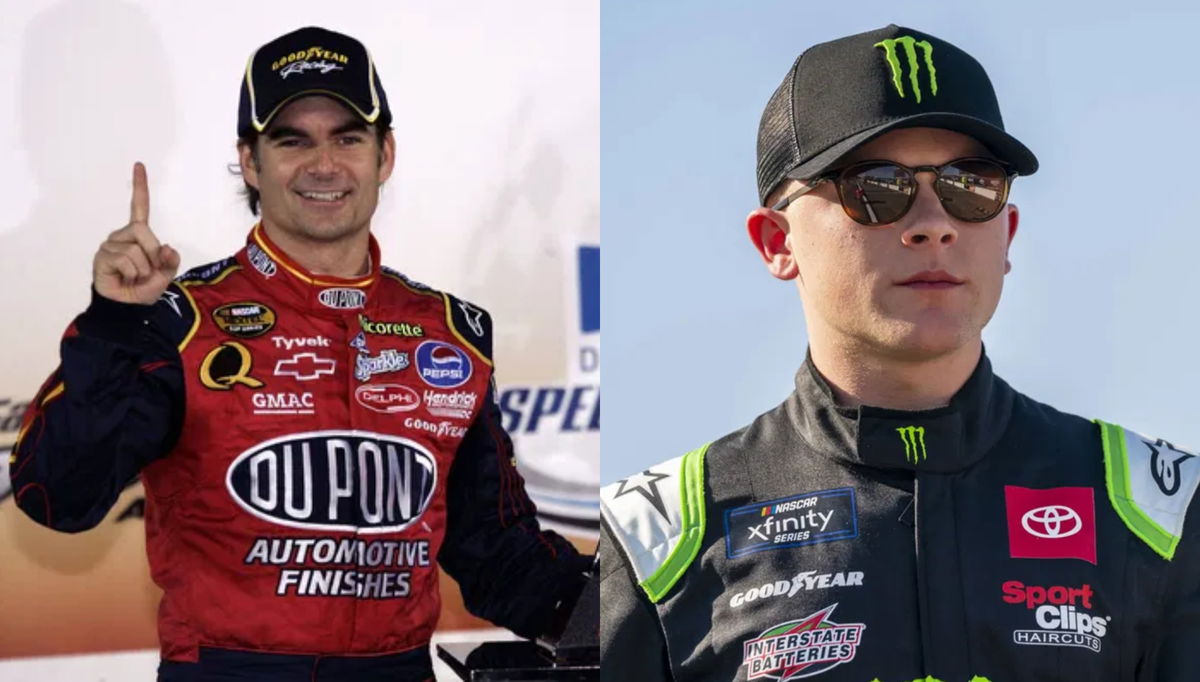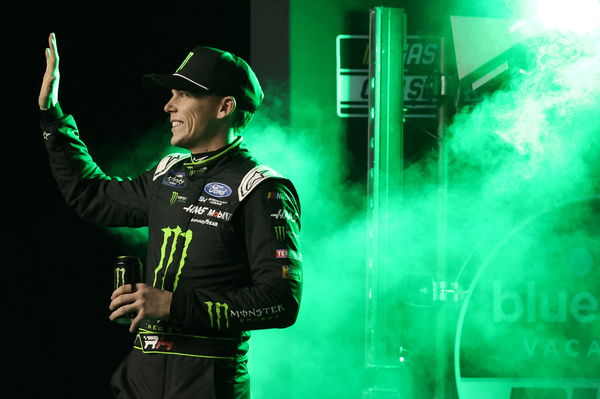

In today’s NASCAR universe, the road to the Cup Series feels more paved with dollars than with dirt and determination, even more so when compared to its glorious times. In the early years of NASCAR, drivers like Jeff Gordon, Tony Stewart, and Jimmie Johnson rose to prominence from grassroots beginnings, often competing on dirt tracks and sprint cars with minimal funding. Gordon, for example, partnered with small-team car owner Rollie Helmling in 1989, and the 17-year-old qualified on pole, winning the prestigious Night Before the 500 race, despite modest backing. These stories now merely reflect a bygone era in which talent and perseverance could break through without massive financial support.
Watch What’s Trending Now!
Another NASCAR Hall of Famer, Tony Stewart’s ascent into NASCAR wasn’t paved with gold. In 1992, a 22-year-old Stewart arrived at Atlanta Motor Speedway, having spent all the money he earned from go-kart prize winnings on new clothes for networking at the track, yet still felt doubtful about his chances. Yet another NASCAR legend, Jimmie Johnson’s early journey into the sport was anything but smooth, as he arrived in North Carolina in 2000, sleeping on a friend’s couch, armed with little more than ambition and a stack of business cards he passed out at every shop in town to make connections.
But fans believe that the same relentless grit and ambition cannot be found in the newer generations of Cup drivers, as they mostly have opportunities lined up for them. Especially with the introduction of new technologies, that make it difficult for the blue-collared class to rise up in the sport, having to face financial concerns. The introduction of the Car of Tomorrow and Next-Gen cars hasn’t eradicated expenses; they just intensified them. Even a single engine today can run $45-80K, with a complete Cup car costing over $125K just to build. For example, running a top-tier team like Penske or Hendrick may cost $20-30M per car annually, making it even important for smaller teams and drivers to avoid on-track mishaps.
ADVERTISEMENT
Modern NASCAR drivers must be as marketable off-track as they are fast on it. Jeff Gordon carried a long-term sponsorship deal with DuPont, but shifting sponsorship dynamics meant dedicating up to eight production days per season to fulfill marketing obligations rather than racing. Even veterans like Dale Earnhardt Jr. called the current charter system expensive, referencing costs topping $50M to own a Cup team. “Today, to just get out there and compete, you need that $50 million charter, and that charter is going to be $100 million and $150 million and $200 million, it’s going to go to the moon over the next several years,” said Junior.

USA Today via Reuters
Feb 15, 2024; Daytona Beach, Florida, USA; NASCAR Cup Series driver Riley Herbst (15) before the Bluegreen Vacations Duel 1 at Daytona International Speedway. Mandatory Credit: Peter Casey-USA TODAY Sports
On the other hand, there are a few drivers who have received top-tier treatments without putting in any extra effort, like Ty Gibbs, landing in his grandfather’s Joe Gibbs Racing, debuting full-time in the Cup Series and winning the 2023 Rookie of the Year with purely family connections. And Riley Herbst clinching a coveted Cup seat at 23XI Racing in 2025 not by dominating on-track, but by bringing long-standing backing from Monster Energy, outpacing more successful drivers without sponsorship.
ADVERTISEMENT
Fans on Reddit often mourn the loss of the core NASCAR era, where ingenuity, not investment, defined success. Club racers once had to fight through seasons on modest budgets of $10-30K yearly. These fans are now divided, as some call for budget caps to rebalance the sport, while others worry that too much regulation could stifle innovation. Yet amid debates, a persistent longing remains for the return to NASCAR’s early days when local heroes could rise on grit and gear alone, and if the older generation of stars could rise up in similar conditions that the sport offers in modern times.
ADVERTISEMENT
Fans reminisce about the days when talent trumped money
Some believe that it is indeed possible, giving the example of some of the most honorable names in NASCAR today. “Thats already happened. Kyles parents only had enough money to get him through outlaw karts,” said one fan. Kyle Larson began racing outlaw karts in North Carolina at just 7 years old, thanks to his parents scraping together enough funds for a $1,2000 second-hand kart. Larson’s father built and maintained the kart himself, encouraging Larson to learn the mechanics through hands-on work, while his mother drove them to local dirt tracks each weekend. Despite a limited budget, this grassroots foundation not only honed his talent but also won the attention of sponsors like Parker Store, signing Larson at age 12 after witnessing his standout performance.
But one fan refuted this storyline by adding, “He also was a participant of the driver diversity program.” After joining Rev Racing in 2012, the Driver for Diversity program offered Larson critical seat team and financial support to learn stock car racing, which became an essential stepping stone that led to wins in the K&N Pro Series Eat and Truck Series, and ultimately to his 2016 victory at Michigan, making him the first D4D graduate to win a Cup race. Larson wasn’t alone in this, as NASCAR offered several non-American drivers the benefit of financial support during their racing tenures after the D4D program was announced.
Others gave further examples to prove that the grit still exists. “Erik jones did it by beating Kyle Busch in the snowball derby twice, without that he never gets the opportunities he got because he lacked funding and sponsorship,” the fan commented. With back-to-back victories at the prestigious Snowball Derby in 2012 and 2013, Erik Jones’ career trajectory changed forever. In the first of those wins, 16-year-old Jones executed a decisive final-pass maneuver with 20 laps to go, holding off Kyle Busch in a bold move that instantly captured national attention. That win wasn’t just about hometown glory; it also earned him a test in a Kyle Busch Motorsports Super Late Model, arranged by spotter Branden Lines and showcased to KBM director Chris Gabehart.
ADVERTISEMENT
There were many who questioned NASCAR’s changes and the reason for which the argument arose in the first place. “Isn’t this one of the reason of 23XI and front row lawsuit? So that the teams get reimbursed enough from NASCAR that way the teams sponsors can pay for drivers? If that’s the case it will go from pay drivers back to PAYING drivers with actual talent,” wrote the fan. This is absolutely correct. The teams themselves argued that the model forces them into ‘take it or leave it’ agreements, limiting revenue access necessary to fund drivers via sponsorships and driving out talent due to high costs. NASCAR‘s financial structure currently also prices out talent unless teams are wealthy or heavily sponsored, and if courts side with them, it could shift the sport back toward supporting paying drivers based on merit, not just money.
Some even argued that the struggling drivers back then are currently thriving in the sport, including Hall of Famers themselves, as one fan argued, “Jimmie still ends up in NASCAR. Ironically I think Tony stays in Indycar and I honestly think that Gordon winds up in F1. I also see Tony getting one of the Andretti F1 seats.” While Johnson and Stewart had plans to stay with NASCAR and IndyCar, respectively, Jeff Gordon nearly crossed continents into Formula 1 before deciding to remain in NASCAR. In 2003, Gordon took part in a cockpit swap with Juan Pablo Montoya at Indianapolis, then engaged in serious discussions with Williams, BAR, and even Bernie Ecclestone about a potential Formula 1 transition. Had the plan materialized, fans speculate that the narrative of motorsport could have shifted dramatically.
As NASCAR continues to evolve, the tension between tradition and transformation grows sharper. The sport’s economic model may need reimagining if it hopes to preserve its pipelines of pure racing talent. While money will always play a role in motorsports, access and opportunity should be sacrificed at its altar. The next great champion could be stuck in the stands, not for the lack of skill, but for the lack of funding.
ADVERTISEMENT
ADVERTISEMENT
ADVERTISEMENT
ADVERTISEMENT

